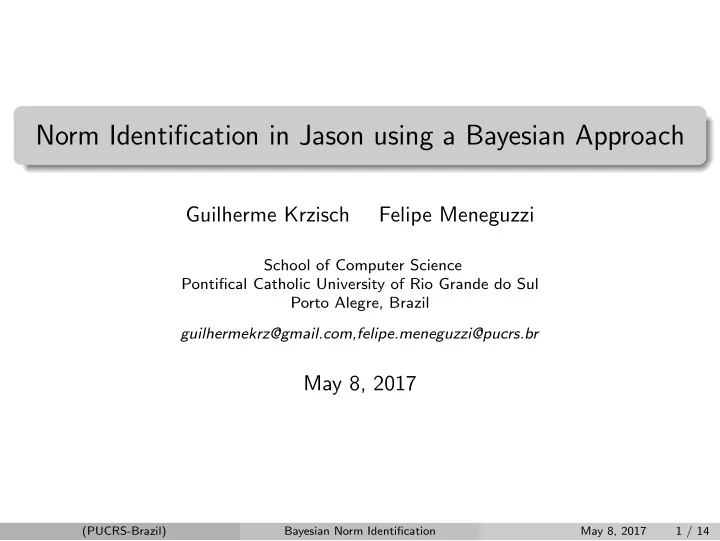

Norm Identification in Jason using a Bayesian Approach Guilherme Krzisch Felipe Meneguzzi School of Computer Science Pontifical Catholic University of Rio Grande do Sul Porto Alegre, Brazil guilhermekrz@gmail.com,felipe.meneguzzi@pucrs.br May 8, 2017 (PUCRS-Brazil) Bayesian Norm Identification May 8, 2017 1 / 14
Overview Introduction 1 Background 2 Norm Detecting System 3 Experiments and Results 4 Conclusion and Future Work 5 (PUCRS-Brazil) Bayesian Norm Identification May 8, 2017 2 / 14
Introduction Open Multi-Agent Systems Normative Environments How to identify existing norms, in order to avoid sanctions? E.g. when there are no explicit norms or if there is no trust between agents Using an existing Bayesian Identification approach We propose a multi-agent system testbed to validate the approach (PUCRS-Brazil) Bayesian Norm Identification May 8, 2017 3 / 14
Background - Norms Definition 1 (Norm) A norm exists in a given social setting to the extent that individuals usually act in a certain way and are often punished when seen not to be acting in this way. Regulate conflicts Coordinate behavior Central vs No central authority Examples: Driving on the left/right side of the road Dueling Smoke in public (PUCRS-Brazil) Bayesian Norm Identification May 8, 2017 4 / 14
Background - Norms Five phases of norm development: 1 Creation 2 Identification - How a new agent entering the society can infer the norms created and currently being enforced in the system 3 Spreading 4 Enforcement 5 Emergence (PUCRS-Brazil) Bayesian Norm Identification May 8, 2017 5 / 14
Background - Norm identification We use a Bayesian approach from Cranefield et al. [1] Norms are defined in a subset of Linear Temporal Logic eventually ( δ ), never ( δ ), next ( γ, δ ), not next ( γ, δ ), eventually ( γ, δ ) and never ( γ, δ ) Weight norm hypothesis according to a set of observations over a model of the system (state-space graph) Alternative interpretation of the Bayes Theorem, which uses odds against a null hypothesis: O ( H 1 : H 2 | D ) = p ( H 1 | D ) p ( H 2 | D ) = p ( H 1 ) p ( D | H 1 ) / p ( D ) p ( H 2 ) p ( D | H 2 ) / p ( D ) = O ( H 1 : H 2 ) p ( D | H 1 ) p ( D | H 2 ) We select the top norm hypothesis (PUCRS-Brazil) Bayesian Norm Identification May 8, 2017 6 / 14
Norm Detecting System - Overview Jason + CArtAgO Park environment Non littering agents and littering agents , with an associated score There is a norm when the majority of the agents is from the same type (PUCRS-Brazil) Bayesian Norm Identification May 8, 2017 7 / 14
Norm Detecting System - State-space graph images/stateSpaceGraph.pdf tex (PUCRS-Brazil) Bayesian Norm Identification May 8, 2017 8 / 14
Norm Detecting System - Algorithm Algorithm 1 Norm Inference Procedure 1: procedure NormInferenceProcedure (stateSpaceGraph) observations ← collect a set of observations 2: normHypotheses ← 3: normIdentificationAlgorithm ( stateSpaceGraph , observations ) topNormHypotheses ← 4: retrieve top hypotheses from normHypotheses filtered ← filter relevant topNormHypotheses 5: for normHypothesis in filtered do 6: check if normHypothesis indicates a litter or not litter norm 7: end for 8: return most probable norm based on the number of 9: each norm indications 10: end procedure (PUCRS-Brazil) Bayesian Norm Identification May 8, 2017 9 / 14
Experiments and Results - Not Litter Example s(start) Observation examples: start i , o , f i(initial) i , w , b , c i , w , b , c , t , n , f buySomething walk Top norm hypothesis: w(wantToBuy) (’c’, ’next’, ’t’)* 1 goToClosestBar o(otherLocation) (’c’, ’not next’, ’r’)* 2 (’c’, ’eventually’, ’n’)* 3 b(atBar) 4 (’l’, ’not next’, ’f’) orderSomething (’c’, ’never’, ’r’)* 5 c(carryingWaste) 6 (’r’, ’never’, ’l’) goToClosestTrashCan goToRandomLocation next (’r’, ’eventually’, ’i’) 7 t(atTrashCan) r(atRandomLocation) 8 (’l’, ’eventually’, ’s’) (’l’, ’eventually’, ’n’) 9 recycle litter 10 (’r’, ’eventually’, ’c’) n(not littered) l(littered) * Indicate a not litter norm next next f(final) (PUCRS-Brazil) Bayesian Norm Identification May 8, 2017 10 / 14
Experiments and Results - 10000 execution cycles Percentage of litter agents # of agents Inferred norm 6 litter 100% to 50 litter 90% 100 litter 6 none 85% to 50 none 10% 100 none 6 not litter 5% to 50 not litter 0% 100 not litter Table: Inferred norms for an increasingly number of agents, and the percentage of littering and non littering agents (PUCRS-Brazil) Bayesian Norm Identification May 8, 2017 11 / 14
Conclusion and Future Work Contributions Norm inference testbed that can be used for experiments of norm-identification algorithms Further experiments to validate the bayesian norm-identification approach by Cranefield et al. , confirming their positive result in a multi-agent setting Future Work Automatically generate the state-space graph of the plan library built in Jason Investigate different ways of combining the top norm hypotheses Run more experiments (PUCRS-Brazil) Bayesian Norm Identification May 8, 2017 12 / 14
References Cranefield, S.; Savarimuthu, T.; Meneguzzi, F.; and Oren, N. (2015) A Bayesian approach to norm identification Proceedings of the 2015 International Conference on Autonomous Agents and Multiagent Systems 1743–1744. Savarimuthu, B. T. R.; Purvis, M.; Purvis, M.; and Cranefield, S. (2008) Social norm emergence in virtual agent societies Declarative Agent Languages and Technologies VI. Springer 1828. (PUCRS-Brazil) Bayesian Norm Identification May 8, 2017 13 / 14
Questions? Norm Identification in Jason using a Bayesian Approach Guilherme Krzisch Felipe Meneguzzi School of Computer Science Pontifical Catholic University of Rio Grande do Sul Porto Alegre, Brazil guilhermekrz@gmail.com,felipe.meneguzzi@pucrs.br May 8, 2017 (PUCRS-Brazil) Bayesian Norm Identification May 8, 2017 14 / 14
Recommend
More recommend